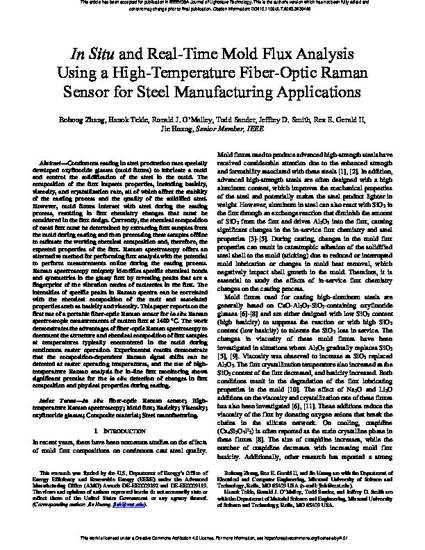
Continuous Casting in Steel Production Uses Specially Developed Oxyfluoride Glasses (Mold Fluxes) to Lubricate a Mold and Control the Solidification of the Steel in the Mold. the Composition of the Flux Impacts Properties, Including Basicity, Viscosity, and Crystallization Rate, All of Which Affect the Stability of the Casting Process and the Quality of the Solidified Steel. However, Mold Fluxes Interact with Steel during the Casting Process, Resulting in Flux Chemistry Changes that Must Be Considered in the Flux Design. Currently, the Chemical Composition of Mold Flux Must Be Determined by Extracting Flux Samples from the Mold during Casting and Then Processing These Samples Offline to Estimate the Working Chemical Composition And, Therefore, the Expected Properties of the Flux. Raman Spectroscopy Offers an Alternative Method for Performing Flux Analysis with the Potential to Perform Measurements Online during the Casting Process. Raman Spectroscopy Uniquely Identifies Specific Chemical Bonds and Symmetries in the Glassy Flux by Revealing Peaks that Are a Fingerprint of the Vibration Modes of Molecules in the Flux. the Intensities of Specific Peaks in Raman Spectra Can Be Correlated with the Chemical Composition of the Melt and Associated Properties Such as Basicity and Viscosity. This Paper Reports on the First Use of a Portable Fiber-Optic Raman Sensor for in Situ Raman Spectroscopic Measurements of Molten Flux at 1400°C. the Work Demonstrates the Advantages of Fiber-Optic Raman Spectroscopy to Document the Structure and Chemical Composition of Flux Samples at Temperatures Typically Encountered in the Mold during Continuous Caster Operation. Experimental Results Demonstrate that the Composition-Dependent Raman Signal Shifts Can Be Detected at Caster Operating Temperatures, and the Use of High-Temperature Raman Analysis for In-Line Flux Monitoring Shows Significant Promise for the in Situ Detection of Changes in Flux Composition and Physical Properties during Casting.
- In situ fiber-optic Raman sensor,
- Basicity,
- Casting,
- Chemicals,
- Chemistry,
- Composite material,
- High-temperature Raman spectroscopy,
- Mold flux,
- oxyfluoride glasses,
- Probes,
- Raman scattering,
- Steel,
- Steel manufacturing,
- Viscosity,
- Viscosity
Available at: http://works.bepress.com/ronald-omalley/119/
